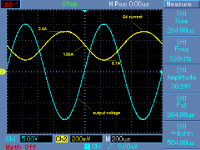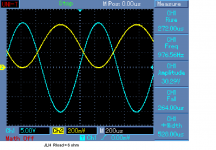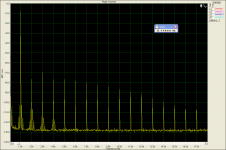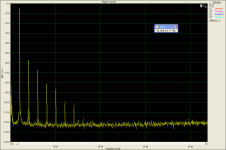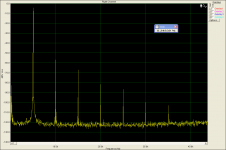jlh reducing distortion
Hi diyers, I have experimented with linsleys-hoods darlington modification(i.e replacing T1 with a pwr darlington mj3001), but i found that to stabilise it you need to add jlh's stabilisation caps that is 1n from tr3 collector to tr4 emitter,a 100ohm 1n series from tr4 collector to gnd and of course a zobel network. btw,distortion is now supposed to be around .01% at 10w! hope someone can simulate this. thanks
Hi diyers, I have experimented with linsleys-hoods darlington modification(i.e replacing T1 with a pwr darlington mj3001), but i found that to stabilise it you need to add jlh's stabilisation caps that is 1n from tr3 collector to tr4 emitter,a 100ohm 1n series from tr4 collector to gnd and of course a zobel network. btw,distortion is now supposed to be around .01% at 10w! hope someone can simulate this. thanks
JLH is NOT a single ended class A. Both upper output transistor and lower CCS transistor are driven and the CCS is modulated by signal. It is able to give about 1.7 x idle current. Real measurement oft the CCS current attached.
I never said that the JLH was a single ended class A amp, but it's distortion profile is not that much different from one. The distortion is high by todays standards, but it is mostly 2nd harmonic. In the bridge mode, that distortion becomes 3rd harmonic. Nelson Pass has writen about this several times. Here are a couple of links:
Discussion of how symetrical distortion produces 3rd harmonic:
http://www.passdiy.com/pdf/distortion_feedback.pdf
Discussion of 2nd harmonic cancellation:
http://www.passdiy.com/pdf/zenlite.pdf
After studying this amp in simulation, I notice that as you push it harder, it starts to predominate in H3 and H5. While it's a seminal design, it really is best no more than 5V below clip. Up until then, the distortion profile looks very single ended.
What is exceptional is the very high percentage of the THD that is confined to H2/H3/H4. At around half power, it approaches 99.5%.
This is highly favourable, explains the good sound quality, at least to me.....
Hugh
What is exceptional is the very high percentage of the THD that is confined to H2/H3/H4. At around half power, it approaches 99.5%.
This is highly favourable, explains the good sound quality, at least to me.....
Hugh
After studying this amp in simulation, I notice that as you push it harder, it starts to predominate in H3 and H5.
No, it does not happen in reality. I have made a huge set of measurements for various supply voltages, idle currents and loads. Near to clipping H3 starts to predominate, but not dramatically. Simulation does not give good results for this amplifier, and extremely depends on accurate models of output devices. Let me show a spectrum near to clipping.
I would like to add that distortion near to clipping strongly depends on idle current and load. The higher the idle current, the lower distortion and contents of higher harmonics. For the reason that the idle current determines characteristic of clipping.
Attachments
Last edited:
I never said that the JLH was a single ended class A amp, but it's distortion profile is not that much different from one.
Yes, this is correct. But distortion is MUCH lower than that of single ended class A amplifiers with same supply voltage and idle current. Incomparably lower.
PMA,
It seems to me that you are disagreeing for the sake of it.
The profile you show clearly indicates H3 and H5 are, to quote, 'starting to predominate'. I did not suggest 'dramatically', you did.
I am quite prepared to accept you are knowledgeable on this amplifier, but you are nitpicking for no good reason, and my comments remain completely valid, regardless of whether it is easy to simulate, models are good, or any other negative connotation of another's work.
You might have commented on my suggestion that since H2/H3/H4 comprised 99.5% of the THD, the sound quality was excellent. This statement is highly arguable.
We both like the sound of the JLH, although THD is relatively high, let's leave it at that.
It seems to me that you are disagreeing for the sake of it.
The profile you show clearly indicates H3 and H5 are, to quote, 'starting to predominate'. I did not suggest 'dramatically', you did.
I am quite prepared to accept you are knowledgeable on this amplifier, but you are nitpicking for no good reason, and my comments remain completely valid, regardless of whether it is easy to simulate, models are good, or any other negative connotation of another's work.
You might have commented on my suggestion that since H2/H3/H4 comprised 99.5% of the THD, the sound quality was excellent. This statement is highly arguable.
We both like the sound of the JLH, although THD is relatively high, let's leave it at that.
This amp still has several advantages over more up-to-date, more powerful class AB and class B designs, that might be important for subjective evaluation of an amplifier sound.
I definitely agree. JLH was a genius.
Many of us are searching for the answer...or can you tell me that it is just one? Yes, it is the most simple one, but it is all...I know lots of better amps, A class or AB class...the first one was Borbely's Hafler DH 220, which I compared just with JLH many years ago (I was using him for tweeter in my active box (JLH) more than three years ), but when DH 220 had come, everything was immediately clear...probably also the Curl's first amps was better...in my opinion, all goes from nostalgia, believe or not...
Last edited:
Wow, great to see Hugh and Pavel chiming in!
Both very knowledgeable and experienced amp designers, so if both of you like the sound of the JLH ... that's good enough for me, I'll try one.
Pavel can be a bit gruff at times; not sure if it's a language issue ...
If you haven't seen it, Nelson did some interesting work with the JLH:
http://6moons.com/industryfeatures/zen/plh.pdf
Cheers,
Jeff
Both very knowledgeable and experienced amp designers, so if both of you like the sound of the JLH ... that's good enough for me, I'll try one.
Pavel can be a bit gruff at times; not sure if it's a language issue ...
If you haven't seen it, Nelson did some interesting work with the JLH:
http://6moons.com/industryfeatures/zen/plh.pdf
Cheers,
Jeff
in my opinion, all goes from nostalgia, believe or not...
Also I have noticed that many like the idea of a very simple circuit - It seems to be appealing even if it is inferior.
I am a big fan of JLH - I learned my electronics by studying his circuits and I built several versions of this simple class A amp . . . but once I heard my higher gain / lower distortion version I cannot go back to the basic version and for me other more recent designs - either folded cascode or current FB out perform it in all relevant areas.
Also I think were he alive today JLH would be taking advantage of new components & topologies.
But the idea that such a simple design can sound good is still so appealing . . .
Many of us are searching for the answer...or can you tell me that it is just one? Yes, it is the most simple one, but it is all...I know lots of better amps, A class or AB class...the first one was Borbely's Hafler DH 220, which I compared just with JLH many years ago (I was using him for tweeter in my active box (JLH) more than three years ), but when DH 220 had come, everything was immediately clear...probably also the Curl's first amps was better...in my opinion, all goes from nostalgia, believe or not...
I have no need to argue with your opinion
Anyway, I find several important points that might be the reason why this design is timeless.
For home listening, I have measured by oscilloscope and by transient recorder that I do not listen at higher voltage amplitudes than 2Vpeak. And most often it is like 500mV peak. So, the power is not an issue and THD at 100W is totally unimportant at such conditions, but 1st watt (as per Nelson), or rather 1st 100mW are important. The JLH, with its quite high idle current and possibility to give about 1.7x idle current for the reason of phase-inverted drive of the upper and lower output device covers low power area much better than ANY class B or class AB biased somewhere at 200mA. And THIS counts. At low power, the JLH has NO higher harmonics in the spectrum, though with high NFB "low distortion" amplifiers you will find low level high order harmonics (above 9th) as a rule of thumb, if you have enough resolution. This results in a dry, tough sound. These high harmonics are a result of NFB that suppresses low order harmonics at expense of creating high order harmonics, yes in a very low level.
The other important point is that JLH distortion is independent of frequency (which is not the case of the MOSFET PLH).
And, the output impedance is not that non-linear as class AB amplifier's.
So, if you do not need high power, this amplifier is perfect. In case you invite 20 people to listen in a room of 100m2 area, then forget JLH, I agree, and get high power high NFB "up-to-date" design, I agree. In case you need to install a sound system for a rock concert, then go for PA and forget ANY hi-end hifi amplifier.
Last edited:
- Home
- Amplifiers
- Solid State
- JLH 10 Watt class A amplifier
